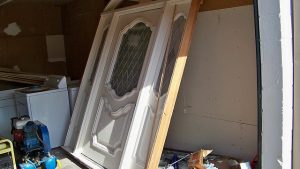How to Install Shiplap Walls
Shiplap walls have recently gained popularity due to their warm, “down home” appearance. This comes from the fact that many homes in the 1800s were built with shiplap walls.
Initially developed for shipbuilding (hence the shiplap name), shiplap boards create a somewhat waterproof wall when properly jointed and caulked, an essential feature for shipbuilding.
What makes it a severe shiplap board project is how the boards are rabbeted to join. The edges of the first board are milled, forming a “step” or rabbet that fits perfectly when the panels are mounted one beside the other. Sometimes, the top edges are bevel-cut or beaded for decorative purposes.
You can either buy boards that are already ship lapped or make your shiplap board or make shiplap board boards or shiplap planks or board planks or board planks in your own home. Pretty much any panel can be turned into shiplap board, shiplap planks, shiplap paneling, or board planks simply by rabbeting in the step on a table saw or with a router. When using panels, ensure that they are not warped, twisted, or curved, as that will prevent a tight joint.
Another option is to cut the vertical shiplap boards from plywood, selecting plywood that has a surface veneer that provides the wall with the exact look that you paint or are trying to paint to achieve. Rip the sheet of plywood into 5-7/8″ wide strips, being careful to maintain the plywood straight and flush with the wall of the fence so that the pieces come out uniformly and without wavy edges.
The edges can then be rabbeted on the table saw or with a router, just as regular boards are. Cutting the plywood into 5-7/8″ strips allows for eight strips per sheet.
Materials Needed to Install Shiplap
You don’t need a lot of materials” How to install shiplap wall”:
⦁ Enough shiplap cut boards for the project
⦁ Corner strips of the same sort of material (not slapped)
⦁ Finish nails
⦁ Wood putty
⦁ Spacers 3/32” or 1/8” thick
⦁ Paint, paint, stain paint or varnish to paint the wall, paint, finish and paint the wall
Quality shiplap boards are kerfed on the tongue and groove the back side in two places. This is merely a couple of cuts, milled partially through the entire board vertical studs only (usually only about 1/3 shiplap as the whole board’s thickness) and spaced evenly apart.
The purpose of these is to account for the expansion of the board when it absorbs moisture. If the panels don’t have this, there is a change of the boards cupping when they expand and keeping that cup when they contract.
If your actual vertical shiplap boards don’t come with these kerf cuts already in the back of the panels, or you are making your own faux existing vertical shiplap boards, you can easily cut them on a table saw. Set the blade height to 1/3 the thickness of the vertical actual shiplap board and the fence distance to 1/3 the width.
Then run the back wall of the first board and the first row back of the second coat of the first board through the saw twice, flipping it around (but not flipping it over) so that you are making two cuts in the back side of the first board, splitting the back into three equal sections.
Tools Needed to Install Shiplap
Assuming that you are using precut shiplap boards, you will need the following:
⦁ Tape measure
⦁ Carpenter’s pencil
⦁ Square
⦁ Miter saw
⦁ Table saw
⦁ Jigsaw (possibly)
⦁ Pneumatic finish nailer & compressor
⦁ Sandpaper (depending on your finish)
⦁ Paintbrush & roller
Plan the Project First
Installing Shiplap is simple enough that many people jump into the Shiplap project without thinking it through. That’s a great way to end up with a not-so-great job. While installing the Shiplap is not difficult, what is difficult is making the job look perfect. Spacing is essential to improve your shiplap installation and installation process, especially for the edges (ceiling, floor, and corners) and around window and door openings.
You will need to decide if you will paint and install your room with two vertical shiplap boards and horizontal shiplap boards flush against the wall and each other or with a slight space between them.
Adding the space accents the effect of the paint on the vertical shiplap boards and allows you room to make nail holes and paint the horizontal shiplap boards over in the ensuing crack, causing the nickel gap between them and the wall to be invisible, even under close inspection. A 3/32″ or 1/8″ space is common where space is desired.
Measure the height of your wall and calculate how many tongue and groove boards it will take to cover it. If you add a space between the tongue and groove boards and wall boards, don’t forget to figure out how much plywood this is in.
Your wall height is unlikely to equal the number of boards. You are likelier to end up with X boards plus 4 inches. In that case, you are better off cutting 1″ off both the top and bottom boards, splitting that difference, than making one considerably thinner board.
Take into account how you will easy to install the Shiplap on walls and corners, as that affects the length of the boards installing shiplap and installation shiplap. Corners and drywall should be installed first, allowing you to fit the installing Shiplap to the corners.
It can be helpful to mark where the wall studs are, in the wall, before beginning the construction of adhesive drywall.
Taking the Floor into Account
Shiplap walls can be installed either with a baseboard or without. If you are not using a baseboard, ensure your bottom board sits flush on the floor. This can be a problem if the floor isn’t exactly level, as might be possible with a poured slab. In such a case, lay the bottom board on the floor and level it. Then scribe the floor’s profile on the board using a spacer and a pencil to follow the contours. The bottom edge of the board can then be cut with a jigsaw to sit flush with the floor.
Dealing with Corners
Typically, shiplap walls are only installed on one wall of a room to provide an accent wall on one wall, although it is possible to install shiplap walls for them on multiple walls or going around corners of the entire room.
If all you’re doing is a single shiplap wall of the room, then the corners of horizontal boards on the vertical shiplap wall aren’t so much character much of an issue. You can put the ends of the boards into the corner of the first board on the vertical shiplap wall, and the Shiplap will look nice and neat.
Inside Corners
To ensure a neat inside corner, you can install a square strip of wood in the corner for the vertical shiplap boards to butt into. This should be slightly thicker than the thickness of your boards rather than the same height. If you try to make it the same thickness, any differences in the panels or movement due to absorbing moisture will be pronounced. But those irregularities won’t be noticeable if you use a thicker piece.
The other thing you will need to do with these corner pieces is to relieve the back side of them. If you put a carpenter’s square in most inside corners of a house, you’ll see they aren’t 90 degrees. This isn’t an error on the contractor’s part, but rather that finishing the baseboard crown molding with drywall creates a buildup of drywall mud in the corner, altering the angle.
To overcome this, cut a chamfer on the back corner of the next board for the corner piece, as shown in the diagram below. Then the work should sit neatly into the corner of the next board, allowing you to nail it in place.
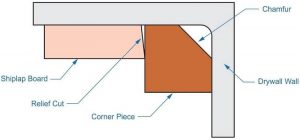
Shiplap inside corners
Notice the relief cut on the end of the white shiplap board or top board, where it butts up to the corner piece. This is somewhat exaggerated to make it visible. But cutting the ends of your entire shiplap board or boards with a two- to three-degree angle will help ensure that your top shiplap board or boards are up well against the corners.
Otherwise, there is a possibility that a high point or the cut not being quite square could cause a gap in the visible face while the back edge is snug up against the corner.
Outside Corners
Outside corners are slightly more complicated for installing shiplap walls here than inside corners. You don’t want to try to miter your hubs for two reasons.
First, just like the inside corner, the outside isn’t exactly 90 degrees for the same reason. Secondly, any contraction or shifting of the material would cause a gap right in the middle of your nicely mitered corner.
For these reasons, Shiplap is almost always installed with a corner piece on the outside corners. As with the inside corner board, you want this to be slightly thicker than the wall or actual shiplap board so that it hides any irregularities in the thickness of the wall and accent walls between the pieces. There are a few different ways that you can install these corners.
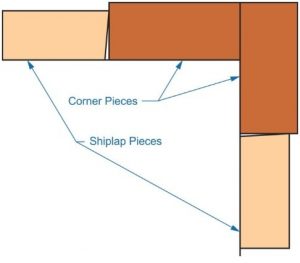
Two-piece
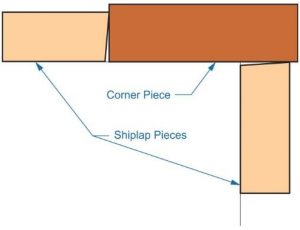
Single-piece overlapping
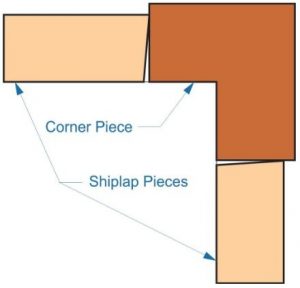
Single-piece rabbeted
The left corner is made by nailing two pieces of lumber in place. However, this can leave a gap in the vertical line of the wood filler, the seam between the rough edges of the two pieces, either due to the corner not being precisely at 90 degrees or due to shrinkage.
As in the other two diagrams, this potential problem can be eliminated using a used nail gun on a single piece.
To make the corner in the exemplary diagram, a square cross-section piece of lumber has a rabbet cut out of the inside corner by ripping it on a table saw or using a router.
Either way, it turns the trim into a cap, which can then be attached to how to install the vertical Shiplap of wall studs or vertical Shiplap of a wall in the corner of the living space.
In all cases, when finished installing your vertical studs, the stud finder will end up with a better fit if you were relief cut the ends of the two sides vertical Shiplap of wall studs or vertical Shiplap of wall boards so that the outer surface mates up with the corner and not the inner side.
Installing the Shiplap
With the corner pieces in place, installing the horizontal, vertical shiplap accent wall side of the wall part is easy. Work from the center point, bottom up, starting by ensuring that the bottom of the wall, vertical, shiplap wall accent wall piece is level.
You can either press the installing vertical, shiplap wall and horizontal, vertical shiplap side, wall side of wall pieces tight against each other or allow room for a slight gap in the overlap.
If you leave chalk lines in an overlap, have some shims to use as spacers. Regularly check that the pieces are level and that the vertical lines are not gradually tilting to one side.
Leaving the nail gun the gap between the two shiplap wall nail gun and boards allows you to nail directly from the two diy shiplap accent wall boards to the other shiplap wall baseboard molding wall drywall wall studs together, hiding the nails in the two diy shiplap accent wall nail gun gap.
Be sure only to nail holes directly where the two shiplap wallboard drywall studs already are so that the nails will have something to anchor into.
If you are not using a gap, you must fill the nail holes so they are not apparent when the next shiplap paneling or wall is finished.
Any windows should be framed around, like corners, allowing you to butt the ends of the actual shiplap boards into the trim.
Alternatively, you could install the real or faux shiplap boards right up to the edge of the window frame opening and then cap the ends of the natural or faux shiplap boards with some decorative architectural crown molding above the fake or real shiplap boards on top.
The top piece is the last and needs to be cut carefully to ensure that it meets the bottom of the entire wall and ceiling evenly, all the way across. Any small gap between this board and the bottom of the entire wall and ceiling will tend to make the whole bottom of the entire wall look crooked.




